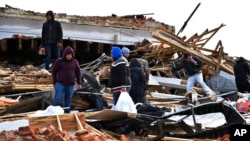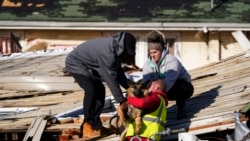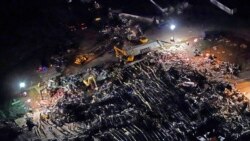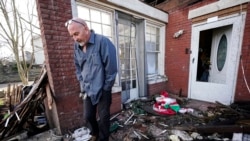Dozens of people have died in the United States, following a series of unseasonal tornadoes that hit several Southern and Midwestern locations Friday. The twisters left behind a path of destruction from weather conditions that usually appear in spring. Authorities say they expect the death toll to rise.
The governor of Kentucky said Saturday that it is likely that at least 70-100 people had died there.
A candle factory in Mayfield, Kentucky, was destroyed by tornadoes. Forty people were rescued from the factory’s rubble. Kentucky Governor Andy Beshear said it would be “a miracle” if any other survivors are found in the factory’s remains.
Jeremy Creason, the city’s fire chief and EMS director, said, “We had to, at times, crawl over casualties to get to live victims.”
“This has been the most devastating tornado event in our state’s history,” Beshear said at a news conference.
Illinois Governor J.B. Pritzker said Saturday that six people were killed when a tornado hit an Amazon warehouse in the middle of a shift change Friday night, collapsing the building. Because of the shift change, authorities do not know if anyone is still unaccounted for.
"This is a devastating tragedy for our Amazon family and our focus is on supporting our employees and partners," Amazon spokesperson Richard Rocha said in a written statement.
U.S. President Joe Biden has spoken to the governors of the five states hit by the tornadoes: Arkansas, Illinois, Kentucky, Missouri, and Tennessee. Biden has approved an emergency declaration for Kentucky, allowing the use of federal funds there.
Biden tweeted Saturday that he was briefed on the situations and said his administration is “working with Governors to ensure they have what they need as the search for survivors and damage assessments continue."
As of Saturday night, at least 36 people were confirmed dead across the five states: 22 in Kentucky, six in Illinois at an Amazon facility, four in Tennessee, two in Arkansas and two in Missouri.
According to early reports, the tornado raced across Kentucky for about 320 kilometers. But Victor Genzini, a researcher on extreme weather at Northern Illinois University, said it may have been on the ground for 400 kilometers. The longest twister on record tracked for about 355 kilometers across Missouri, Illinois and Indiana in March 1925.
The tornado in Mayfield was one of at least four that devastated at least 10 counties in Kentucky.
"It was absolutely the most terrifying thing I've ever experienced in my life," one of the Mayfield factory workers, Kyanna Parsons-Perez, said in an interview that aired on NBC's Today show. "I did not think I was going to make it," she said.
Storms also swept through the Kentucky city of Bowling Green, killing an off-campus Western Kentucky University student, according to the university’s president. Eleven of Kentucky’s confirmed deaths were from Bowling Green.
Kentucky Governor Beshear declared a state of emergency, activated the Kentucky National Guard and deployed the state police.
In neighboring Tennessee, at least four people were killed as storms traversed the state, according to Tennessee Emergency Management Agency Chief of Staff Alex Pellom.
Missouri Governor Mike Parson's office said at least two people were killed in the towns of Defiance and New Melle and more were injured in building collapses. Hundreds of buildings were destroyed or damaged, according to initial assessments.
A tornado also hit a nursing home in Monette in northern Arkansas, killing one person and trapping 20 people inside as the building collapsed, according to Craighead County Judge Marvin Day. He said five people sustained serious injuries and a few received minor ones.
Day said first responders rescued those trapped in the building that was “pretty much destroyed.”
Another person died when the storm hit a Dollar General store in nearby Leachville, Arkansas Governor Asa Hutchinson said, according to The Associated Press.
"Probably the most remarkable thing is that there's not a greater loss of life," Hutchinson said after touring the wreckage of the nursing home. "It is catastrophic. It's a total destruction."
Scientists are warning with increasing urgency that global warming is making storms more powerful and frequent, posing even greater threats to areas where extreme weather is already common.
Some information for this report came from The Associated Press, Reuters and Agence France-Presse.













